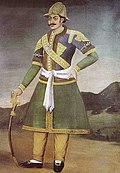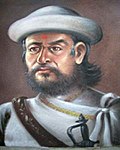Khas Rajput
Khas Rajput (Devanagari: खस राजपूत) is a community among Khas people that claims to be Rajputs (warrior-ruler). The term is popularly denoted to Khas people who follow Hindu tradition in the Indian state of Uttarakhand. It is used very less in Nepal and is replaced by the term Chhetri.
History
Traditionally, the Khas people were divided into "Khas Brahmins" (also called Bahuns in Nepal) and "Khas Rajputs" (also called Chhetris in Nepal). In Garhwal regions of Uttarakhand in India, the Khas Brahmins and Khas Rajputs had a lower social status than the other Brahmins and Rajputs. However, in present-day western Nepal, and in Uttarakhand they had the same status as the other Brahmins and Rajputs, possibly as a result of their political power in the Khasa Malla kingdom.[1]
Khas Rajputs in Kumaon region of Uttarakhand are historically accepted as army recruits for the hill Rajas.[2] In Uttarakhand, Gharwal region there are two general divisions of Rajputs - Asal Rajput and Khas Rajput. Asal Rajput are the immigrants of the lowlands of India while Khas Rajput are children of the local Khas population.[3][4] Now there is no such divisions.
They have been connected to the Khasas mentioned in the ancient Hindu literature. Historian Bal Krishna Sharma and Dor Bahadur Bista speculates that the Khas people were of Indo-European origin. Historian Baburam Acharya speculates that Khas are a sub-clan of Aiḍa, an Arya clan originated at Idavritt (modern day Kashmir). Khas were living in the Idavaritt in the 3rd millennium B.C.E. and the original meaning of the term Khas was Raja or Kshatriya (Yoddha). He further speculates that Kashmir has been named from its local residents Khas as Khasmir. In the 2nd millennium B.C.E., one group of Khas migrated towards Iran while the other group migrated east of Sutlej river settling only in the hill regions up to Bheri River. Historian Balkrishna Pokhrel contends that Khas were not the Vedic Aryans but Aryans of latter period like the Gurjara, Darada, Shaka, Pallava and Pisacha. He further asserts that post-Vedic Aryans were akin to Vedic Aryans in terms of language and culture.[source?]
Notable people
- MS Dhoni,[2] Indian cricketer
- Trivendra Singh Rawat , Indian Politician
- Yogi Adityanath, Indian Politician
- Harish Rawat, Indian Politician
- Bipin Rawat, Indian army chief
- Unmukt Chand, Indian cricketer
- Urvashi Rautela, Indian actress
Khas Rajput Media
Bhimsen Thapa, Prime Minister and de-facto autocratic ruler of Nepal from 1806 to 1837
Jang Bahadur Rana, Premier and de-facto autocratic ruler of Nepal; also a patriarch of historical Rana dynasty (1846-1951)
Portrait of Prime Minister Kalu Pande wearing Khukuri, a Pande Chhetri aristocrat; Kaji (Prime Minister and Army Chief) of Gorkha Kingdom.
Prime Minister Abhiman Singh Basnyat, a Basnyat Kshetri Mulkaji
Late Queen Indra Rajya Lakshmi Devi of Nepal, mother of King Birendra and King Gyanendra, was from Rana Chhetri dynasty
Portrait of King Prithivi Narayan Shah, founder of modern Nepal, consulting with army chief Shivaram Singh Basnyat
Bir Shamsher JBR, a Rana Kshetri Maharaja and Prime Minister
Late Queen Aishwarya of Nepal; a Rana Chhetri
Bidya Devi Bhandari, first woman President of Nepal & Commander-in-Chief was born in a Pandey Chhetri family
Former Head of Nepalese Army, Rajendra Chhetri (KC)
Sources
- ↑ John T Hitchcock 1978, pp. 116-119.
- ↑ 2.0 2.1 Sandhu, Veenu (30 April 2011). A village in Kumaon. http://wap.business-standard.com/article/beyond-business/a-village-in-kumaon-111043000027_1.html.[dead link]
- ↑ Negi, Sharad Singh. Kumaun: The Land and the People. Indus Publishing. ISBN 9788185182896.
- ↑ Garhwal Himalayas: A Study in Historical Perspective, by Ajay S. Rawat. Published by Indus Publishing, 2002. ISBN 81-7387-136-1. Page 43-44.
Books
- John T Hitchcock (1978), Himalayan Anthropology: Indo-Tibetan interface, ISBN 9789027977007









